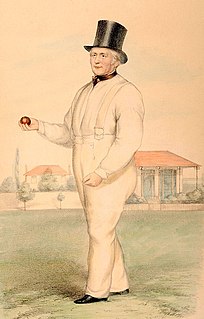Related Research Articles
Arthur Haygarth was a noted amateur cricketer who became one of cricket's most significant historians. He played first-class cricket for the Marylebone Cricket Club and Sussex between 1844 and 1861, as well as numerous other invitational and representative teams including an England XI and a pre-county Middlesex. A right-handed bat, Haygarth played 136 games now regarded as first-class, scoring 3,042 runs and taking 19 wickets with his part-time bowling. He was educated at Harrow, which had established a rich tradition as a proving ground for cricketers. He served on many MCC committees and was elected a life member in 1864.
1826 was the 40th season of cricket in England since the foundation of Marylebone Cricket Club (MCC). The revival of inter-county cricket gathered pace and William Clarke made his known first-class debut.

1800 was the 14th season of cricket in England since the foundation of Marylebone Cricket Club (MCC). It is one of the more difficult seasons to analyse because of several matches involving prominent town clubs like Rochester, Woolwich, Homerton, Richmond, Storrington, Montpelier and Thames Ditton.
1817 was the 31st season of cricket in England since the foundation of Marylebone Cricket Club (MCC). Cricket was hit by a controversial match-fixing scandal.
1822 was the 36th season of cricket in England since the foundation of Marylebone Cricket Club (MCC). John Willes brought the roundarm issue to a head and sacrificed his own career in the process. The outstanding batsman James Saunders made his known first-class debut.
1825 was the 39th season of cricket in England since the foundation of Marylebone Cricket Club (MCC). The pavilion at Lord's was destroyed by fire. Many irreplaceable documents which recorded early cricket matches are believed to have been lost. The impact of this upon cricket's history is that it is only since 1825 that surviving records can be viewed with anything like complete confidence. Inter-county matches are recorded for the first time since 1796. Two of the greatest players of the 19th century, William Lillywhite and Ned Wenman, made their first known appearances in important matches.
1824 was the 38th season of cricket in England since the foundation of Marylebone Cricket Club (MCC). Gentlemen v Players was an odds game with 14 on the Gentlemen team, but the Players still won by 103 runs.

Frederick William Lillywhite was an English first-class cricketer during the game's roundarm era. One of the main protagonists in the legalisation of roundarm, he was one of the most successful bowlers of his era. His status is borne out by his nickname: The Nonpareil.
The Prince of Wales Ground, also known as Prince's Ground, in Brighton, Sussex was the venue for top-class cricket matches in the closing years of the 18th century.
Brighton Cricket Club was based at Brighton, Sussex and was briefly a top-class team, playing seven matches between 1791 and 1814 which have been given first-class cricket status. It is often seen as being representative of Sussex as a county.
Frederick Woodbridge was an English amateur cricketer who made 9 known appearances in first-class cricket matches from 1815 until 1819. He was the younger brother of Edward Woodbridge.
Felix Calvert Ladbroke was an English banker and amateur cricketer.
James Bray was an English professional cricketer who played first-class cricket from 1816 to 1828. He was mainly associated with Sussex and made 8 known appearances in first-class matches, including 2 matches for The Bs between 1817 and 1828.
James Cobbett was an English professional cricketer who played first-class cricket from 1826 to 1841 for Middlesex, Surrey and Sheffield Cricket Club. Considered by many - according to The Cricketer and Wisden - to be "the finest allrounder of his day", Cobbett was a right-handed batsman, occasional wicket-keeper and right arm slow roundarm bowler.
1826 in sports describes the year's events in world sport.
1815 was the 29th season of cricket in England since the foundation of Marylebone Cricket Club (MCC). A discernible recovery began as the Napoleonic Wars ended.
James Peter Pollitt was an English cricketer.
James Wells was an English cricketer. Wells was the brother of cricketer John Wells.
James Hopper was an English first-class cricketer associated with Kent who was active in the 1820s. He is recorded in three matches from 1822 to 1827, totalling 56 runs with a highest score of 26 and holding 3 catches.
References
- ↑ "James Ladbroke". CricketArchive. Retrieved 2 June 2013.